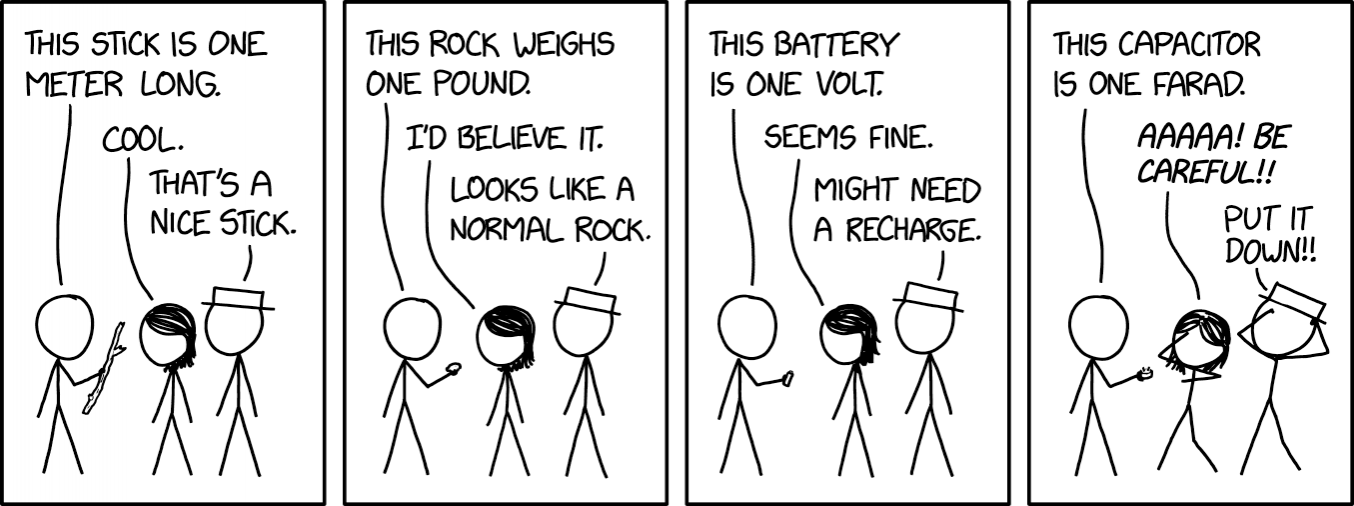Unit utility
« previous post |
The mouseover title: "'This HAZMAT container contains radioactive material with activity of one becquerel.' 'So, like, a single banana slice?'"
explainxkcd currently fails to explain the strip's implicit reference to the entry for bogosity in the Jargon File:
1. [orig. CMU, now very common] The degree to which something is bogus. Bogosity is measured with a bogometer; in a seminar, when a speaker says something bogus, a listener might raise his hand and say “My bogometer just triggered”. More extremely, “You just pinned my bogometer” means you just said or did something so outrageously bogus that it is off the scale, pinning the bogometer needle at the highest possible reading (one might also say “You just redlined my bogometer”). The agreed-upon unit of bogosity is the microLenat.
2. The potential field generated by a bogon flux; see quantum bogodynamics. See also bogon flux, bogon filter, bogus.
The Jargon File gives this explanation of "microLenat":
The unit of bogosity. Abbreviated µL or mL in ASCII. Consensus is that this is the largest unit practical for everyday use. The microLenat, originally invented by David Jefferson, was promulgated as an attack against noted computer scientist Doug Lenat by a tenured graduate student at CMU. Doug had failed the student on an important exam because the student gave only “AI is bogus” as his answer to the questions. The slur is generally considered unmerited, but it has become a running gag nevertheless. Some of Doug's friends argue that of course a microLenat is bogus, since it is only one millionth of a Lenat. Others have suggested that the unit should be redesignated after the grad student, as the microReid.
More of the (complex and contested) background can found in the 8/29/2006 LLOG post. Wikipedia's only coverage (I think) is an entry in a List of Humorous Units of Measurement., although the dimensional analysis issues are well explained in the entry on the FFF system.

Stephen Goranson said,
June 25, 2025 @ 7:43 am
Reminds me of [Oliver] Smoots, the measurement units of the length of the Charles River/Mass. Ave. Bridge, starting from the Cambridge (MIT) side to Boston.
languagehat said,
June 25, 2025 @ 8:09 am
OK, I haven't felt this clueless since the physics course for physics majors I foolishly took in college (I was not a physics major), but I do not understand "the strip's implicit reference to the entry for bogosity in the Jargon File." Could someone explain?
Mark Liberman said,
June 25, 2025 @ 8:31 am
@languagehat: "I do not understand "the strip's implicit reference to the entry for bogosity in the Jargon File." Could someone explain?"
The Jargon File entry notes that the Farad (as a unit of capacitance, named after Michael Faraday) is way too large for current everyday use, wherefore the capacitors that people were/are used to using in circuit design are rated in "micro Farads", i.e. millionths of a Farad. Or even "pico Farads" ("pf"), i.e. billionths of a Farad.
The diss was then that the unit of "bogosity" should be the Lenat, named after Doug Lenat; but he was (according to the diss) so extremely bogus that everyday bogosity should be quantified in micro Lenats, namely millionths of a Lenat.
So it's a stupid nerdly joke, but I'd be surprised if this joke, and the Jargon File in general, wasn't in Randall Munroe's intellectual history, and in the back of his mind in a strip about Farads being impractically large. Of course I could be wrong.
Gregory Kusnick said,
June 25, 2025 @ 9:21 am
The power supplies in 1950s-era TVs and radios typically used large capacitors in the range of tens of millifarads. As a teenage electronics hacker I managed to collect enough of these to assemble a one-farad capacitor bank, which I used to vaporize small bits of aluminum foil.
Brett said,
June 25, 2025 @ 9:46 am
@Stephen Goranson: The name of that bridge is actually (surprisingly) the Harvard Bridge. (Amusingly, Oliver Reed Smoot later became head of the American National Standards Institute—fitting for man who was a unit himself.)
@Mark Liberman: As someone who sometimes teaches introductory E & M, I routinely have to point out to students how large a unit the farad is,* with everyday capacitances typically in the range of nanofarads (billionths) or picofarads (trillionths). And, although I was familiar with the units of bogosity, I would never have seen a connection between them and the topic of this cartoon; it seems like could be said it has about as much to do with the millihelen—the unit of beauty necessary to launch one ship.
* For those unaware, the reason the farad is so vast is that a 1 F capacitor would store 1 coulomb of charge a very modest potential of 1 volt. The volt is a reasonably sized unit; however, the coulomb is a really large amount of charge, necessitating that a 1 F capacitor be enormous. The reason, in turn, that 1 C of charge is so large is that the coulomb unit is based on a standardized magnetic force, rather than an electrical force, which turns out to mean that the coulomb ends up being proportional to c², and the speed of light c is very, very large
Not Helen said,
June 25, 2025 @ 10:11 am
@Brett — ah, the milliHelen! One of my favorites, along with the milliFermat, which is 1/1000 the time it took to prove Fermat's Last Theorem, approx 4 months. It's useful for estimating project duration.
Here's a large list of other units of measurement.
https://phrontistery.info/unit.html
david said,
June 25, 2025 @ 10:34 am
Multifarad supercapacitors have been available since the late seventies. Small ones are pretty safe to hold.